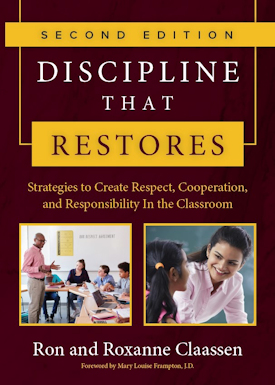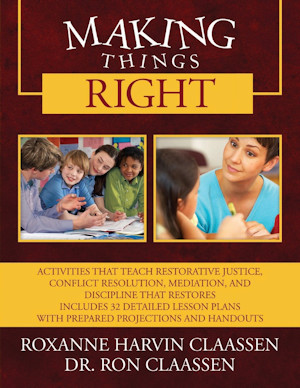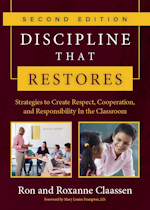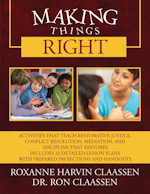Ron and Roxanne have written two books and a number of articles (found at the DTR Resources/Articles tab) to assist those who want to establish a Restorative Justice Discipline system in their classroom and school. The Yellow Cards and Posters supplement and add value when implementing DTR in your classroom. The books are available in any quantity through Amazon.com. Just click on the picture. Posters and yellow cards are ordered via email disciplinethatrestores16@gmail.com
 
Discipline That Restores (Second Edition 2020)
Understanding the core issues of getting students to cooperate has never been so clear and concise. In this second edition, widely respected authors and educators, Ron and Roxanne Claassen, maintain the core restorative justice discipline system that makes things as right as possible, while adding new insights and evidence/research. The original Latin definition of discipline (disciplina) did not include punishment. Discipline (needed to prevent and respond to misbehavior) was focused on learning and teaching. Teachers and Students using DTR Teach and Learn:
- The dangers and opportunities of conflict and misbehavior
- How to recognize and respond to an escalating conflict
- Responsibility through development of classroom respect agreements
- That trust grows when agreements are made and kept (teacher/student and student/student)
- A Visual Model of 4 Options that assists in deciding and inviting a constructive response to conflict and misbehavior
- Respect and appreciation for differences
- Listening and Speaking Skills to transform confrontation into cooperation
- A Peacemaking Model
- Step by step processes to constructively address injustices and other conflicts or problems
- The carefully constructed Flowchart to guide a constructive and restorative justice escalation when necessary.
- How to mediate conflicts at school and home
- Accountability, the value of and process for following up on agreements
Ron and Roxanne Claassen, maintain Discipline That Restores (DTR's) carefully constructed discipline system while adding their new learnings, updates, research/evidence, and additional references for deepening understanding of restorative justice discipline theory, skills and strategies. For more than thirty years teachers and administrators have been utilizing DTR as their discipline system to create a climate of respect while increasing accountability in their classrooms and schools.
DTR uniquely blends theory, strategies, and best practices of Conflict Resolution Education, Peacemaking, Mindfulness, and Restorative Justice, and is illustrated with a multitude of case studies to form an effective discipline system. DTR supports the positive behavior of all students and is especially effective with those students who are most resistant to authority by involving them in processes that empower them to be responsible and accountable. DTR transforms discipline into learning experiences that decrease stress, improve effectiveness, and build relationships. DTR is grounded in Ron's extensive and pioneer work in Restorative Justice (RJ) and Victim Offender Reconciliation Program (VORP) and Roxanne's 20 years of adapting the theory, skills and strategies of RJ and VORP to transform her school's punitive discipline to restorative discipline. Punishment for misbehavior causes resentment to grow and damages teacher/student relationships, at least a little, and sometimes a lot. Even when a DTR teacher or administrator uses their power and authority, it is done in a way that is reasonable, respectful, restorative, and intended to reintegrate (not exclude) the student. Schools using DTR reduce or eliminate suspensions and expulsions because they are not needed, not because the authorities are being permissive and overlooking bad behavior. DTR transforms a school's systemic punishment discipline to a system that is reasonable, respectful, restorative, and reintegrative for all, students, teachers, administrators, and parents. DTR eliminates disproportional use of punishment and disparity caused by intentional or unintentional bias. Evidence shows that DTR responses transform a potentially destructive event into a teaching and learning situation for everyone involved while building relationships. Initially Roxanne's personal experience as well as the experiences of thousands of teachers at all levels and in all types of schools have shown that students, kindergarten and above, understand and respond constructively to DTR.
Making Things Right
Making Things Right is designed to be used in several ways: - To train students to become mediators and peacemakers in their classroom and at home and as peer mediators for their school.
- To train students to understand and participate in a restorative justice/discipline structure in the classroom based on the book Discipline That Restores: Strategies to Create Respect, Cooperation, and Responsibility in the Classroom by Ron and Roxanne Claassen.
- To train parents who want to understand and use a constructive conflict management strategy in their families.
Making Things Right is divided into three sections. The first section consists of the lesson plans for each of thirty-two activities. The second section is called Projections and Handouts (larger print makes them easier to read when projected). The third section consists of the Student Folder Items. The time listed for each activity is an approximation and provided to help the teacher determine how they want to combine or use individual activities to fit their time frames.
Making Things Right is designed to be used both for whole-class trainings in which lessons are taught on a daily basis spread over several days for one to two weeks, and for two-day student mediator training seminars. Our preference is to use the lessons with the entire class so all have the skills and strategies to be peaceful problem solvers.
Making Things Right is especially helpful for educating students about the theory, skills and strategies used in Discipline That Restores, also by Ron and Roxanne Claassen. Discipline That Restores gives teachers and administrators the knowledge and skills for implementing restorative justice discipline in the classroom and school. It is important for students to have as much knowledge of this structure and process as their teachers and school administrators, so all are better able to constructively resolve conflicts together. Lessons are designed to help students learn and become equipped to understand and implement conflict and peacemaking theory, skills and strategies. Students will learn some theory and be encouraged to develop their own theories for why we are interested in learning about new strategies for problem solving, and they will participate in lessons that will teach a specific process to use for problem solving and peacemaking as individuals in relationship with others and as mediators.
Making Things Right provides activities that build student understanding of the mediation process and gives students a chance to practice the process through roleplay. This training will enable students to develop practical skills that will help them respond constructively to conflicts in many areas of their own lives as well as help others.
Punishment for misbehavior causes resentment to grow, and what appears as evil intent is a consequence of that resentment. Punishment damages relationship at least a little and sometimes a lot. Since it is rare that misbehavior involves only one person, the most effective way to respond to misbehavior is to gain the cooperation of each person involved and then to sit down with them and help them solve the problem. Responding this way transforms an otherwise destructive event into a teaching and learning situation for everyone involved and builds relationship.
Experience shows that students, kindergarten and above, can understand and respond constructively. Students grade four and above can readily understand and use these concepts in their own interpersonal conflicts and as mediators. Roxanne used this curriculum for many years with her 8th grade students and with parents. Many have used this curriculum to train high school students. All teachers make some adaptations to best use it with their audience.
Yellow Cards and 3 Posters
Supplemental support materials for Discipline That Restores & Making Things Right
Yellow Cards: Four Options Model (side one) and Peacemaking Process (side two)(4 ¼" x 2 ¾")
Posters: Four Options Model, Peacemaking Process, and DTR Classroom Flow Chart (18" x 24")
The Four Options Model and the Peacemaking Model/Process were designed by Ron Claassen. The Four Options Model side of the Yellow Card (also available in poster size) visually describes the four basic ways that a decision is made or a conflict is addressed: #1 Coercive Power, #2 Outside Authority, #3 Cooperative Resolution with a Mediator, #4 Direct Cooperative Resolution. It is a central model for implementing both Discipline That Restores (DTR) and Making Things Right (MTR) by Ron and Roxanne Claassen and is an essential tool of Restorative Justice. When misbehaving or defiant students, actually all people in conflict, look at the model (the visual is essential), they almost always choose a cooperative process (#3 or #4) to resolve the conflict. Chapter 6 of DTR is devoted to providing in depth understanding and examples. Activity 8 of MTR provides a lesson plan for teaching the model and its uses to students.
"Like all brilliant things in life, [The Four Options Model] is elegant, simple, and unfortunately not well enough known. We need to spread it out. When People begin to grasp its significance, it will be even more powerful. It has the power to transform our society." -Doug Noll, Mediator/Attorney/Educator
The Peacemaking Process side of the card (also available in poster size) is the short version of a peacemaking process designed to cooperatively (with or without a mediator, #3 or #4) address a conflict, misbehavior, violation, or injustice. Chapter 7 of DTR is devoted to a full explanation of both how it was designed and how it can be applied. Activities 20-26 of MTR provide lesson plans to teach students to use the Peacemaking Process and the Four Options Model.
The DTR Classroom Flow Chart describes the constructive escalation steps for implementing DTR in a classroom. It is based on 20 years of experience implementing restorative justice discipline in Roxanne's classroom. Each step on the Flow Chart is a Chapter in Discipline That Restores. The poster is visible to all students as a reminder of the discipline plan. Making the restorative discipline process visually available to students increases accountability and fairness.
Supplemental Support Materials
We offer four different packages:
- 100 Yellow Cards - Two sides - Four Options Model and Peacemaking Process (4 ¼" x 2 ¾"). Retail Price with Free Shipping $30.00
- 500 Yellow Cards - Two sides - Four Options Model and Peacemaking Process (4 ¼" x 2 ¾"). Retail Price with Free Shipping $75.00
- 20 Sets of Three Posters - Black Print on Yellow (18" x 24"). Retail Price with Free Shipping $150.00
- 1 Classroom Set of Three Posters (one each) and 250 Yellow Cards. Retail Price with Free Shipping $50.00
Posters are packed in tube.
Orders must be pre-paid.
Payment may be made via check or PayPal.
|



